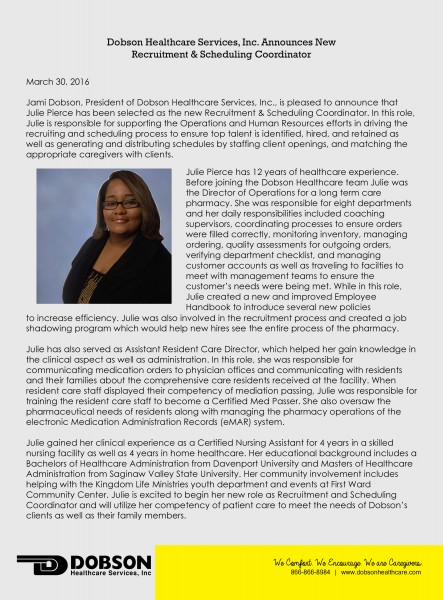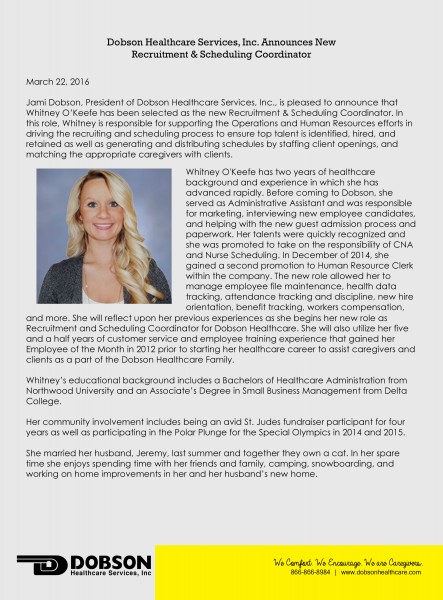The Recruitment & Scheduling Coordination (RSC) Team ensures unsurpassable Continuity of Care on the staffing and scheduling side of the departments at Dobson Healthcare. It is a supporting branch of the Human Resources and Operations Teams. The RSCs lead the recruiting process to identify, hire, and retain the most qualified candidates for caregiver positions. They are also responsible for generating and distributing client care schedules. Now that our full RSC Team is assembled, our Marketing Communications Associate sat down with the three members to get you the scoop on their daily activities!
Throughout the month of April, Dobson Healthcare along with the the American Occupational Therapy Association, Inc. (AOTA) and “…more than 213,000 occupational therapists, occupational therapy assistants, and students who work nationwide to create fuller lives for clients and their families…” celebrate Occupational Therapy Month (AOTA, 2016).
What is Occupational Therapy?
Often confused with being associated strictly to the workforce- or a person’s occupation- Occupational Therapy (OT) is actually a more inclusive therapy than most realize. OT involves the development, recovery, or maintaining of daily living. Daily living for a individual can include self-care, homemaking, leisure, education, and work. According to AOTA¹, OT services generally include:
- An individualized evaluation, during which the client/family and Occupational Therapist determine the person’s goals
- Customized intervention to improve the person’s ability to perform daily activities and reach the goals
- Outcomes evaluation to ensure that the goals are being met and/or make changes to the intervention plan
The Bureau of Labor Statistics² states additional duties of an Occupational Therapist as well as Occupation Therapy Assistants and Aides:
- Help people with various disabilities with different tasks, such as teaching a stroke victim how to get dressed
- Demonstrate exercises and other therapeutic activities—for example, stretching the joints for arthritis relief—that can help relieve pain in people with chronic conditions
- Recommend special equipment, such as wheelchairs and eating aids, and instruct patients on how to use that equipment
- Lead children who have developmental disabilities in play activities that promote coordination and socialization
- Encourage patients to complete activities and tasks
- Transport patients
- Promote safety education and support
Goals: The Key to OT
The main goal of OT is all about “…restoring function and promoting independence through the use of occupation-based treatment…” (Hartwig, 2016). To accomplish these goals, Occupational Therapists assist individuals by adapting the environment or task as well as teach the individual the skills needed to perform such actions. Goals are created using the term SMART (Specific, Measurable, Attainable, and Time-sensitive). Example goals³ used in a OT program can include:
- The patient will push self up into quadruped position with minimal physical assistance and maintain position for 2 minutes for 2/2 trials.
- The patient will pull-over shirt with minimal assistance while seated with mod trunk support for 3/5 attempts, to increase level of independence with dressing.
- The patient will demonstrate functional shoulder/arm hand control for improved fine motor abilities..
- When given an assignment that involves the use of scissors, the patient will appropriately use scissors to cut 100% of the time on 4 out of 5 trials.
- The patient will consistently respond to cue to recall presence of food tray and initiate self‐feeding 80% of trials.
Who Uses OT?
Occupational Therapy can assist individuals of all ages. OT can also be utilized for short term assistance as well as throughout the entire lifespan of an individual. It is a collaborative process between the individual needing OT, the family, the therapist, and other professionals involved including (but not limited to) teachers, doctors, and businesses. The following list provides insight to who typically uses OT services. Please note: there can be other individuals than those listed who use OT.
- Patients with permanent disabilities (such as those due to having Cerebral Palsy, Autism, or the loss of limb)
- Individuals recovering from a Traumatic Brain Injury and/or Spinal Cord Injury
- Infants and toddlers who have, or are at risk of having, developmental delays
- Individuals with a mental illness
- Individuals who are emotionally unbalanced
- Older adults experiencing physical and cognitive changes (such as the on-set of Alzheimer’s Disease)
- Patients with chronic conditions (such as Diabetes and Arthritis)
- Individuals recovering from surgery (such as hip replacement)
Want to Learn More?
To learn more about Occupational Therapy visit The American Occupational Therapy Association’s website at www.aota.org
To learn about coordinating your Occupational Therapy visit Dobson Healthcare’s Care and Services page at www.dobsonhealthcare.com/superior-service/staffing-services/
¹ AOTA. (n.d.). About Occupational Therapy. Retrieved April 12, 2016, from www.aota.org
² Bureau of Labor Statistics (2015, December 17). What Occupational Therapists Do. Retrieved April 12, 206 from www.bls.gov
² Bureau of Labor Statistics (2015, December 17). What Occupational Therapy Assistants and Aides Do. Retrieved April 12, 2016 from www.bls.gov
³ Malone M. L. (2012, March 9). Interventions for Treating Persons with Dementia. Retrieved April 12, 206 from www.ohioslha.org
³ eQHealth (2012 January). Writing Measurable Short and Long Term Goals. Retrieved April 12, 206 from fl.eqhs.org
AOTA. (2016 April) April is Occupational Therapy Month. Retrieved April 12, 2016 from www.aota.org
Hartwig, M., Seaman, C., Williams, S., & Witherspoon, S. (2016, March 24). Occupational Therapy: Changing lives for the better everyday. Retrieved April 08, 2016, from www.ourmidland.com
Ithaca College Department of Occupational Therapy. (n.d.). What is Occupational Therapy?. Retrieved April, 12, 2016 from www.ithaca.edu
Nature is calling!
Do you hear the call to head outside now that the weather is getting warmer and the sun shines brightly in the sky longer? We’ve spent the winter days cooped up indoors, now is the time to head out and breathe in the fresh Spring air! So go out exploring; take a walk during your lunch break; immerse yourself in Mother Nature’s beauty! Here’s 5 great examples of the healthiness of heading outdoors.
Camping.com. (n.d.). Camping.com. Retrieved April 06, 2016, from www.camping.com
Friedman and Kevin Loria, L. F., & Loria, K. (2014, April 09). 11 Scientifically Proven Reasons You Should Go Outside. Retrieved April 06, 2016, from www.businessinsider.com
Murphy, J. (2014). 4 Reasons to Go Outside (if you care about your health). Retrieved April 06, 2016, from whole9life.com
National Wildlife Federation. (n.d.). Health Benefits. Retrieved April 06, 2016, from www.nwf.org
Tesco. (n.d.). 8 reasons why walking is great for your health. Retrieved April 06, 2016, from www.tescoliving.com
Our quarterly newsletter has been published!
Read about our additions to the Dobson Healthcare Family, upcoming events, healthcare news, safety tips and more in our latest edition in Thrive: A Message from Dobson Healthcare!
Please click here to view the latest edition of Thrive.
You know the saying, April showers bring May flowers? Summer is right around the corner! So we wanted to “shower” you with wellness tips to prepare for those “budding” summer months.
Our First Wellness Tip Monday focuses on the rule we’ve been told since childhood: Drink 8 oz. of water every day. Now days, the recommendation for you daily water intake of water depends on your age, weight, activity level, and various other factors. However, the bottom line is that it is essential to drink water every day. But why is it so important? Here’s 5 reasons you should drink more water:
Aquino, I. (2013, August 24). Reasons to Drink Water. Retrieved April 04, 2016.
StayingHealthy. (2013). Health Benefits of Water: H2O Not Just For Hydration. Retrieved April 04, 2016.
Top 10 Home Remedies. (2013). Top 10 Health Benefits of Drinking Water. Retrieved April 04, 2016.
With the arrival of Spring and warm weather, comes the blossoming of flowers, leaves growing on the trees, and the potential for severe storms.
During the Spring, we can see a variety of weather hazards including:
- Heavy Rains
- Floods
- Heat
- High Winds
- Lightning
- Rip Currents/Beach Hazards
- Tornadoes
- and more!
It’s important that we understand what to do when severe weather we see during the warmer months of the year happens. Below is a list of a few proper safety protocols to prepare for severe weather.
- Have a written plan for what you will do in an emergency. Don’t forget to include your pets in your emergency planning!
- Share your plan with family, friends, care providers and other in your personal support network.
- If you have an emergency (fire, medical emergency, down electrical wires, hazardous material spill, gas leak etc.) CALL 911
- Severe Weather Warning means severe weather is imminent, occurring, or likely in your area and is a threat to life and property. Everyone in the warning area needs to take immediate action.
- Shelter in place- Have a designated safe area in the home that offers the most protection from high winds, falling objects, and away from glass windows.
- Evacuation- There may be conditions in which you will decide to evacuate or are ordered to leave; in this case, you need to choose several designated shelters located in different directions from your home that you can go to when these conditions arise.
- Keep a list of family members and emergency contacts along with their contact information; i.e. phone number, text, email address.
- Prepare basic survival kits, one for if you stay where you are and a second kit for if you have to leave. What should you include in your survival kit?
- Water
- Food
- Battery powered radio
- Flashlight
- First aid kit
- Whistle
- Dust mask
- Moist towelettes
- Garbage bags
- Local maps
- Pet food
- Medications
- Cash
- Monitor radio and TV stations located in your immediate area for any updates in weather conditions.
- What are the safety precautions for down electrical wires? STAY AWAY AND DO NOT TOUCH.
- If there is a gas leak in your community, stay indoors (if possible) and block air flow from entering around windows and doors. If you have to evacuate, go upwind from source.
- For flooding conditions stay on high ground, avoid the current, and wait for emergency personnel and equipment to assist moving you.
Department of Homeland Security. (2014). Basic Disaster Supplies Kit. Retrieved March 15, 2016.
Weather-Ready Nation. (n.d.). Spring Has Sprung! Get Ready for Some of America’s Wildest Weather! #SpringSafety. Retrieved March 15, 2016.








